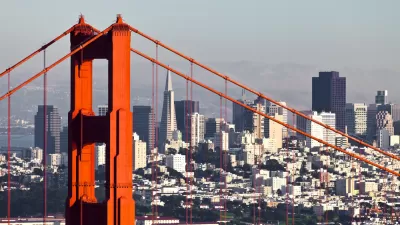California and Massachusetts use the same name for climate change legislation, Global Warming Solutions Act, and set the same target date for reductions, 2020. Both achieved their targets 2016, but the Bay State had a tougher goal to meet.

The Global Warming Solutions Act of 2008 (aka Chapter 298) was signed into law by Mass. Gov. Deval Patrick (D). See (and listen to) Adam Reilly's July 2017 WGBH interview on WGBH of Sen. Marc R. Pacheco (D-Taunton), the law's author, and David Ismay, a senior attorney at the Conservation Law Foundation, which successfully took the state to court, for background on the landmark law.
The Massachusetts law is stronger than California's Global Warming Solutions Act of 2006 (aka Assembly Bill 32) in two important ways:
- It calls for greenhouse gas (GHG) reductions "between 10 percent and 25 percent below statewide 1990 GHG emission levels by 2020," while AB 32 just called for reduction to "1990 levels."
- It set a future target date of "80 percent below statewide 1990 GHG emission levels by 2050."
It it true that both California Govs. Schwarzenegger (R) and Brown (D) did call for the same 2050 goal, but those were in the form of executive orders [S-3-05 (pdf) and B-30-15, respectively] as opposed to legislation. Senate Bill 32, approved by the legislature in 2016, extended California's climate law to 2030, calling for reductions to 40 percent below 1990 levels.
Benjamin Swasey of WBUR reports on Jan. 4 that greenhouse gas emissions in Massachusetts declined 2.5 percent in 2016, the year of the most recent greenhouse gas inventory, from 2015. According to the Department of Environmental Protection (MassDEP), emissions decreased by 21% between 1990 and 2016.
By contrast, it was widely reported last July that California had reduced its 2016 emissions, also its most recent GHG inventory, to 1990 levels, meeting its AB 32 goal four years early.
Transportation is tops
Another similarity between the two states – the transportation sector is the largest source of emissions, at 39 percent in Massachusetts and 41 percent in California.
Last month, the Bay State joined with eight other East Coast states and the District of Columbia to develop a policy to price emissions from transportation, set a 'cap' on them, and invest the revenues in low carbon transportation solutions, similar to what California has been doing since 2015 when transportation fuel was added to the cap-and-trade program.
Additional reading: "Climate Change Law in California and Massachusetts: Lessons for State Policy Makers" [pdf], Hastings Environmental Law Journal, Jan 1, 2015.
FULL STORY: The State's Emissions Declined 2.5 Percent In 2016. They're Now 21 Percent Below 1990 Levels

Alabama: Trump Terminates Settlements for Black Communities Harmed By Raw Sewage
Trump deemed the landmark civil rights agreement “illegal DEI and environmental justice policy.”

Study: Maui’s Plan to Convert Vacation Rentals to Long-Term Housing Could Cause Nearly $1 Billion Economic Loss
The plan would reduce visitor accommodation by 25% resulting in 1,900 jobs lost.

Planetizen Federal Action Tracker
A weekly monitor of how Trump’s orders and actions are impacting planners and planning in America.

Waymo Gets Permission to Map SF’s Market Street
If allowed to operate on the traffic-restricted street, Waymo’s autonomous taxis would have a leg up over ride-hailing competitors — and counter the city’s efforts to grow bike and pedestrian on the thoroughfare.

Parklet Symposium Highlights the Success of Shared Spaces
Parklets got a boost during the Covid-19 pandemic, when the concept was translated to outdoor dining programs that offered restaurants a lifeline during the shutdown.

Federal Homelessness Agency Places Entire Staff on Leave
The U.S. Interagency Council on Homelessness is the only federal agency dedicated to preventing and ending homelessness.
Urban Design for Planners 1: Software Tools
This six-course series explores essential urban design concepts using open source software and equips planners with the tools they need to participate fully in the urban design process.
Planning for Universal Design
Learn the tools for implementing Universal Design in planning regulations.
Caltrans
Smith Gee Studio
Institute for Housing and Urban Development Studies (IHS)
City of Grandview
Harvard GSD Executive Education
Toledo-Lucas County Plan Commissions
Salt Lake City
NYU Wagner Graduate School of Public Service




























